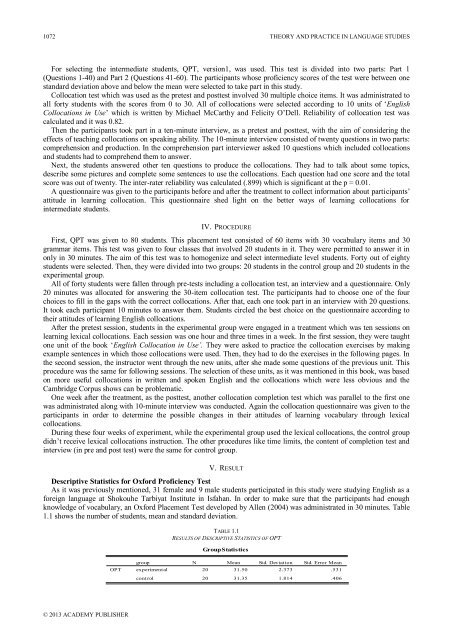Theory and Practice in Language Studies Contents - Academy ...
Theory and Practice in Language Studies Contents - Academy ...
Theory and Practice in Language Studies Contents - Academy ...
You also want an ePaper? Increase the reach of your titles
YUMPU automatically turns print PDFs into web optimized ePapers that Google loves.
1072 THEORY AND PRACTICE IN LANGUAGE STUDIESFor select<strong>in</strong>g the <strong>in</strong>termediate students, QPT, version1, was used. This test is divided <strong>in</strong>to two parts: Part 1(Questions 1-40) <strong>and</strong> Part 2 (Questions 41-60). The participants whose proficiency scores of the test were between onest<strong>and</strong>ard deviation above <strong>and</strong> below the mean were selected to take part <strong>in</strong> this study.Collocation test which was used as the pretest <strong>and</strong> posttest <strong>in</strong>volved 30 multiple choice items. It was adm<strong>in</strong>istrated toall forty students with the scores from 0 to 30. All of collocations were selected accord<strong>in</strong>g to 10 units of „EnglishCollocations <strong>in</strong> Use‟ which is written by Michael McCarthy <strong>and</strong> Felicity O‟Dell. Reliability of collocation test wascalculated <strong>and</strong> it was 0.82.Then the participants took part <strong>in</strong> a ten-m<strong>in</strong>ute <strong>in</strong>terview, as a pretest <strong>and</strong> posttest, with the aim of consider<strong>in</strong>g theeffects of teach<strong>in</strong>g collocations on speak<strong>in</strong>g ability. The 10-m<strong>in</strong>ute <strong>in</strong>terview consisted of twenty questions <strong>in</strong> two parts:comprehension <strong>and</strong> production. In the comprehension part <strong>in</strong>terviewer asked 10 questions which <strong>in</strong>cluded collocations<strong>and</strong> students had to comprehend them to answer.Next, the students answered other ten questions to produce the collocations. They had to talk about some topics,describe some pictures <strong>and</strong> complete some sentences to use the collocations. Each question had one score <strong>and</strong> the totalscore was out of twenty. The <strong>in</strong>ter-rater reliability was calculated (.899) which is significant at the p = 0.01.A questionnaire was given to the participants before <strong>and</strong> after the treatment to collect <strong>in</strong>formation about participants‟attitude <strong>in</strong> learn<strong>in</strong>g collocation. This questionnaire shed light on the better ways of learn<strong>in</strong>g collocations for<strong>in</strong>termediate students.IV. PROCEDUREFirst, QPT was given to 80 students. This placement test consisted of 60 items with 30 vocabulary items <strong>and</strong> 30grammar items. This test was given to four classes that <strong>in</strong>volved 20 students <strong>in</strong> it. They were permitted to answer it <strong>in</strong>only <strong>in</strong> 30 m<strong>in</strong>utes. The aim of this test was to homogenize <strong>and</strong> select <strong>in</strong>termediate level students. Forty out of eightystudents were selected. Then, they were divided <strong>in</strong>to two groups: 20 students <strong>in</strong> the control group <strong>and</strong> 20 students <strong>in</strong> theexperimental group.All of forty students were fallen through pre-tests <strong>in</strong>clud<strong>in</strong>g a collocation test, an <strong>in</strong>terview <strong>and</strong> a questionnaire. Only20 m<strong>in</strong>utes was allocated for answer<strong>in</strong>g the 30-item collocation test. The participants had to choose one of the fourchoices to fill <strong>in</strong> the gaps with the correct collocations. After that, each one took part <strong>in</strong> an <strong>in</strong>terview with 20 questions.It took each participant 10 m<strong>in</strong>utes to answer them. Students circled the best choice on the questionnaire accord<strong>in</strong>g totheir attitudes of learn<strong>in</strong>g English collocations.After the pretest session, students <strong>in</strong> the experimental group were engaged <strong>in</strong> a treatment which was ten sessions onlearn<strong>in</strong>g lexical collocations. Each session was one hour <strong>and</strong> three times <strong>in</strong> a week. In the first session, they were taughtone unit of the book „English Collocation <strong>in</strong> Use’. They were asked to practice the collocation exercises by mak<strong>in</strong>gexample sentences <strong>in</strong> which those collocations were used. Then, they had to do the exercises <strong>in</strong> the follow<strong>in</strong>g pages. Inthe second session, the <strong>in</strong>structor went through the new units, after she made some questions of the previous unit. Thisprocedure was the same for follow<strong>in</strong>g sessions. The selection of these units, as it was mentioned <strong>in</strong> this book, was basedon more useful collocations <strong>in</strong> written <strong>and</strong> spoken English <strong>and</strong> the collocations which were less obvious <strong>and</strong> theCambridge Corpus shows can be problematic.One week after the treatment, as the posttest, another collocation completion test which was parallel to the first onewas adm<strong>in</strong>istrated along with 10-m<strong>in</strong>ute <strong>in</strong>terview was conducted. Aga<strong>in</strong> the collocation questionnaire was given to theparticipants <strong>in</strong> order to determ<strong>in</strong>e the possible changes <strong>in</strong> their attitudes of learn<strong>in</strong>g vocabulary through lexicalcollocations.Dur<strong>in</strong>g these four weeks of experiment, while the experimental group used the lexical collocations, the control groupdidn‟t receive lexical collocations <strong>in</strong>struction. The other procedures like time limits, the content of completion test <strong>and</strong><strong>in</strong>terview (<strong>in</strong> pre <strong>and</strong> post test) were the same for control group.V. RESULTDescriptive Statistics for Oxford Proficiency TestAs it was previously mentioned, 31 female <strong>and</strong> 9 male students participated <strong>in</strong> this study were study<strong>in</strong>g English as aforeign language at Shokouhe Tarbiyat Institute <strong>in</strong> Isfahan. In order to make sure that the participants had enoughknowledge of vocabulary, an Oxford Placement Test developed by Allen (2004) was adm<strong>in</strong>istrated <strong>in</strong> 30 m<strong>in</strong>utes. Table1.1 shows the number of students, mean <strong>and</strong> st<strong>and</strong>ard deviation.TABLE 1.1RESULTS OF DESCRIPTIVE STATISTICS OF OPTGroup StatisticsOPTgroupexperimentalcontrolN Mean Std. Deviation Std. Error Mean20 31.50 2.373 .53120 31.35 1.814 .406© 2013 ACADEMY PUBLISHER
















